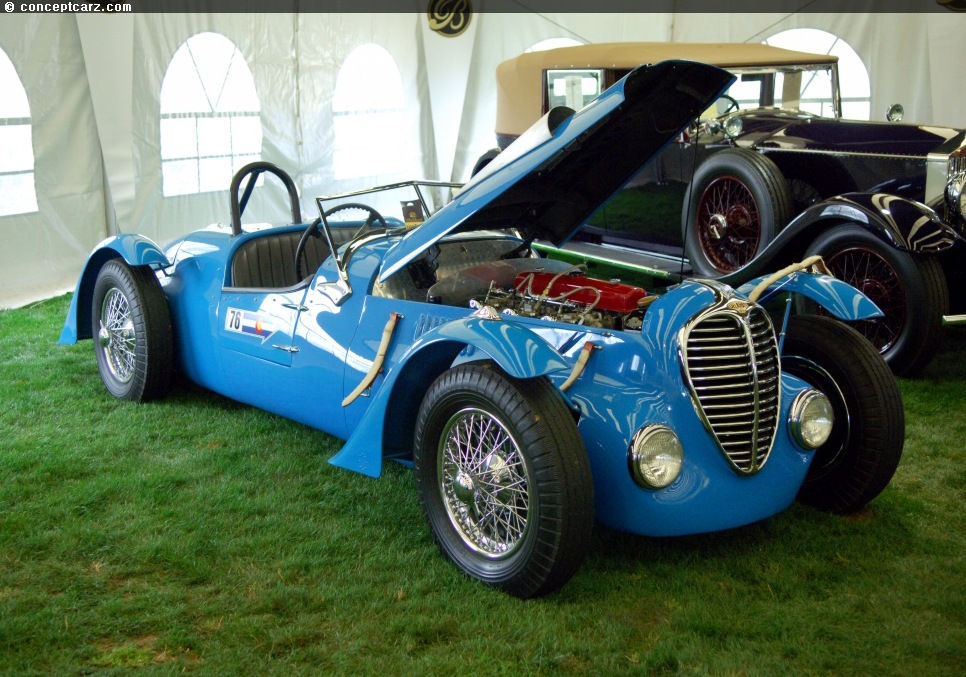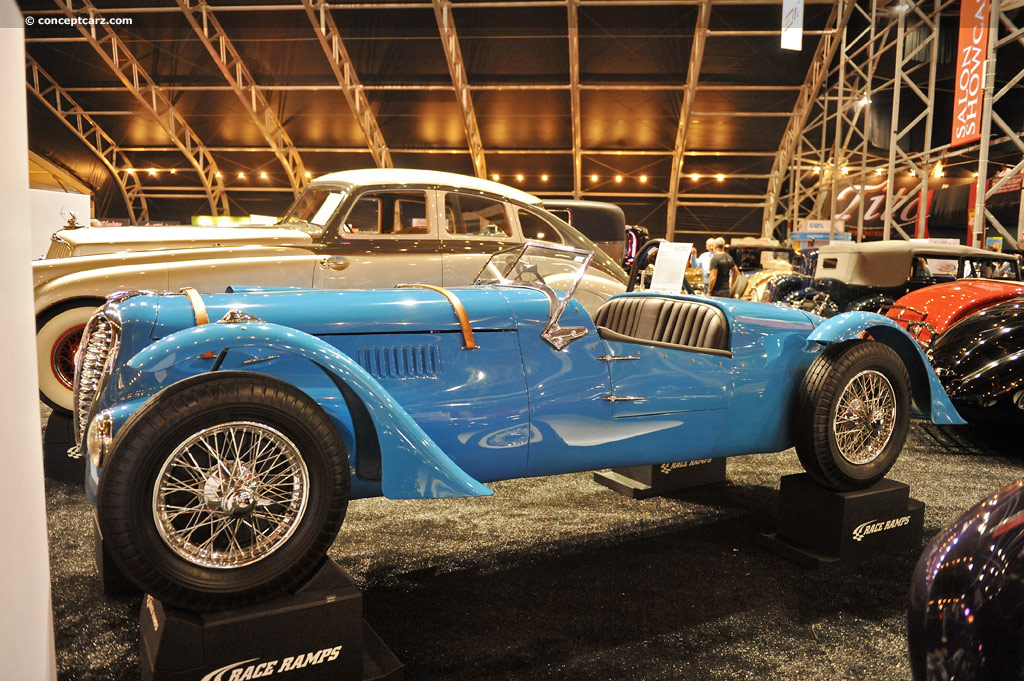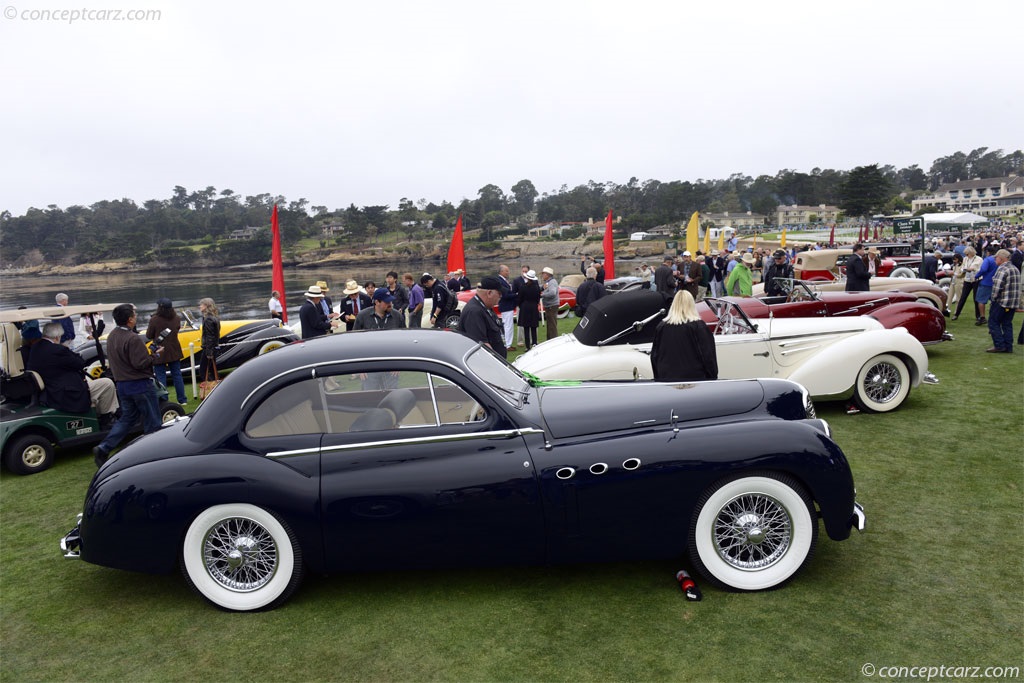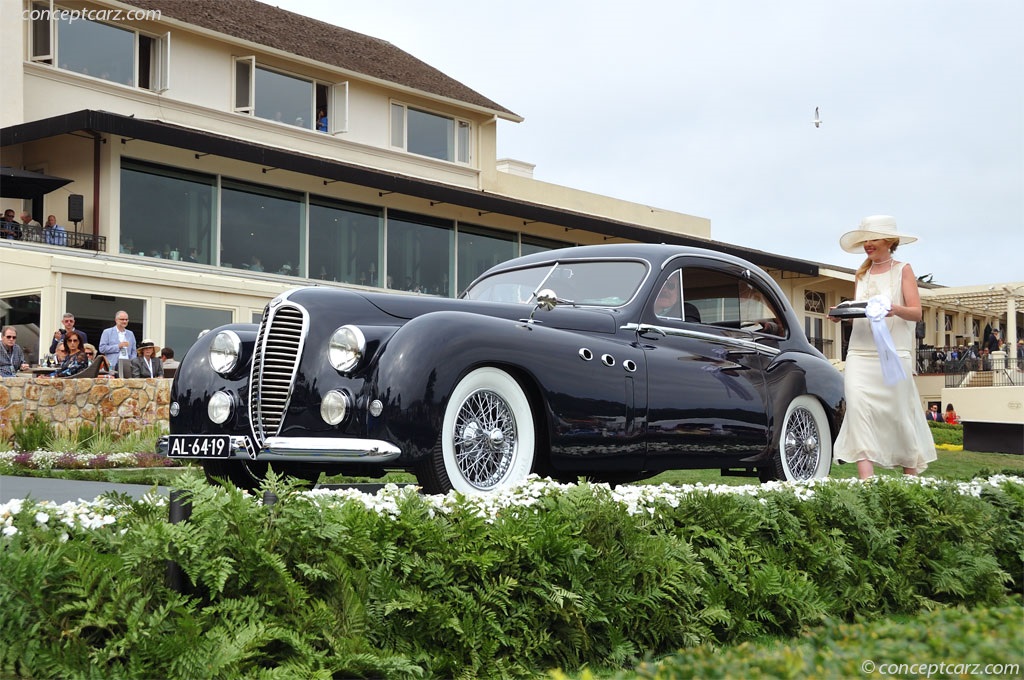Delahaye was founded by Émile Delahaye in 1894 in Tours, France, and in 1898, manufacturing was moved to Paris. Emile was a railroad engineer who designed rolling stock for the French and Belgian railroads. In 1895, he designed his first car with a similar design and engineering to the German Daimler. When the company moved to Paris, it began a variety of engineering projects. Their first shaft-drive car arrived in 1907 and a V-6 engine as early as 1912. 
Roadster
Chassis #: 800518During World War I, they produced stationary engines, aircraft components, and gun parts. When peacetime resumed, they built durable, albeit mundane, automobiles. Additionally, they manufactured commercial vehicles, buses, fire trucks, and trucks. A racing department was added in 1932, setting several international records, and won numerous races, including the Monte Carlo Rally in 1937 and the 24 Hours of Le Mans in 1938. In 1936, they placed 2nd, 3rd, 4th, and 5th at the French Grand Prix. The arrival of the Type 135 prototype at the Paris Auto Salon in 1933 would signal the company's intention of delving completely into the low-volume, sporty, luxury car segment.The Delahaye Type 135 was would become the company's most successful model ever. It had a low-slung chassis, frequently clothed with stylish, versatile, and lightweight coachwork, and powered by a straight 6-cylinder, 3.6-liter engine topped with a trio of Solex carburetors. The Type 135 was built from 1935 through 1954 and is lauded as the financial savior of the Delahaye marque. It would become the marque's mainstay for the remainder of its existence and was technically advanced and delightful to drive.
Roadster
Chassis #: 800518Approximately 1,155 examples of the 135 M and 135 MS were built through around 1952.SpecificationThe 3.2-liter (3,227cc) overhead-valve, reverse-flow straight-six cylinder engine was derived from the company's truck engine. It had a four-bearing crankshaft and was initially installed in a long wheelbase Delahaye Type 138. With twin carburetors installed, the output was rated at 95. With three downdraught Solex carburetors, output rose to 110 bhp. Production of this 3.2-liter engine continued through 1940, ending with the German occupation. 
Coupe by Letourner et Marchand
View info and historyA larger, 3.5-liter (3,557cc) version was introduced in 1936, delivering 90, 105, or 115 horsepower depending on the number of carburetors (one, two, or three, respectively). Production of this engine would continue through the mid-1950s (albeit with a temporary halt during World War II). The Type 135 rested on a new, 116-inch wheelbase low-slung (low, but not under-slung) chassis designed by engineer Jean François with welded box section side members and pressed cross members welded to a ribbed floor pan. The suspension used independent, transverse leaf springs at the front (carried over from the Type 138) and a live axle at the rear with semi-elliptical leaf springs. Cable-operated 14-inch Bendix brakes provided the stopping power. At all four corners were 17-inch spoked wheels. Transmission options included a four-speed manual with synchromesh on the third and four gear and a four-speed Cotal MK38 electro-magnetic preselector gearbox. As Delahaye did not have in-house coachbuilding facilities, the bodies were outsourced to independent coachbuilders. Among the list of coachbuilders who clothed the Type 135 included Figoni & Falaschi, Jacques Saoutchik, Alphonse Guilloré, Letourneur et Marchand, Marcel Pourtout, Frères Dubois, Marius Franay, Faget-Varnay, Antem, Henri Chapron, and others. The Delahaye Type 135M
Coupe by Letourner et Marchand
View info and historyThe Delahaye Type 135M, powered by the 3,557cc engine, would earn great success due to its slender form, reliable engine, and balanced handling. A longer wheelbase version (measuring 3,150mm) was built as the Type 148 or with an even longer 3,350mm wheelbase and seven-seater configuration. For customers who desired an even smaller version of the Type 135M, Delahaye offered the TYpe 134N with a shorter wheelbase and powered by a 2,150cc four-cylinder version of the 3.2-liter six. The Delahaye Type 135MS (Modifiée Spéciale)The engine powering the Type 135MS offered between 120 and 145 horsepower depending on the configuration. In competition guise, output surpassed 160 bhp. Most were built for competition, with the road-going versions perched atop a 2.95m wheelbase, while the racing versions had a 2.70m platform. 
Coupe by Letourner et Marchand
View info and historyIn 1954, Delahaye merged with another French automaker, Hotchkiss. The new company ended Delahaye's automobile production.
by Daniel Vaughan | Mar 2023

Roadster
Chassis #: 800518

Roadster
Chassis #: 800518

Coupe by Letourner et Marchand
View info and history

Coupe by Letourner et Marchand
View info and history

Coupe by Letourner et Marchand
View info and history
by Daniel Vaughan | Mar 2023
Related Reading : Delahaye Type 135 History
was born in Tours, France in 1843. He studied engineering in Angers, France. In 1869 he began work with his engineering degree in applied arts and crafts. Emile Delahaye began business in Tours, France in the middle of the 19th century for the purpose of constructing engines for the ceramic industry. The company branched out and began constructing mechanical appliances such as pumps and engines.....
Continue Reading >>
Continue Reading >>
1949 Delahaye Type 135 MS Vehicle Profiles
Recent Vehicle Additions
Related Automotive News

Concours d'Elegance of America at St. John's : Best of Show
The Concours dElegance of America, established in 1978, featured over 300 significant automobiles on the beautiful green at the Inn at St. Johns in Plymouth, Michigan. This years featured classes included Vintage Bentley, Auto Show 55, Bonneville...

HOW FORD, RAILROAD INDUSTRY CREATED INNOVATIVE WAY TO SHIP THE NEW TRANSIT VAN TO NORTH AMERICAN CUSTOMERS
Innovative new railcar for vehicle shipping accommodates the variety of Ford Transit roof heights
Optimized mix of rail and truck transport provides the most efficient delivery time and lowest shipping cost, and supports Fords Blueprint for Sustai...

ALL-NEW FORD TRANSIT: BETTER GAS MILEAGE THAN E-SERIES; BEST-IN-CLASS GAS ENGINE TORQUE, CARGO CAPACITY
All-new 2015 Ford Transit low- and medium-roof regular-wheelbase wagons with available 3.5-liter EcoBoost® have a 46 percent better EPA-estimated highway fuel economy rating* than Ford E-Series with premium gas engine
Proven 3.5-liter EcoBoost offe...

FLEET CUSTOMERS, COMMERCIAL BUSINESS OWNERS, FORD DEALERS INVITED TO TEST DRIVE ALL-NEW FORD TRANSIT
Ford kicks off nationwide Truth About Transit Tour to provide fleet customers, commercial business owners and Ford dealers an opportunity to test drive the all-new Ford Transit, learn about the vehicles Built Ford Tough credentials and get question...

2,000 NEW FORD KANSAS CITY EMPLOYEES CELEBRATE START OF PRODUCTION OF GAME-CHANGING 2015 FORD TRANSIT VAN
With 2,000 new jobs and a %241.1 billion investment, Kansas City Assembly Plant begins Ford Transit van production Ford now more than 75 percent toward its goal of creating 12,000 hourly jobs in the United States by 2015
Ford Transit is the newest...



































